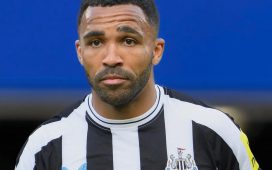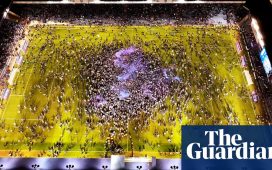In every other way, it was a marquee event. The sight of 69,274 fans, a stadium record attendance, packed into CenturyLink Field was enough to illustrate this, although the elaborate pre-game TIFOs, pyrotechnics and ‘March To The Match’ from downtown Seattle out to the venue only added to the spectacle. Indeed, last year’s MLS Cup final had all the components of a Big Match, besides one: the pitch.
Like every Seattle Sounders home game since the club’s introduction to the league in 2009, last year’s MLS Cup final was played on an artificial grass surface. FieldTurf, to be precise. It was the same the season before as Atlanta United hosted the Portland Timbers at Mercedes-Benz Stadium. That too was a big time sporting occasion to rival anything produced by the Champions League, Europa League or any other European competition. Just like in Seattle, though, the plastic pitch was out of place.
Artificial surfaces are permitted in the Champions League, but not for the final. In 2008, for instance, a new grass pitch was hastily laid just a few weeks before the Champions League final between Chelsea and Manchester United because the Luzhniki Stadium’s usual plastic pitch was deemed unsuitable for such a big match. This gives a sense of how Uefa truly feel about their use at the elite level of the European game.
There is not a single artificial pitch in the Premier League, nor is there one in the Championship. In fact, there isn’t an artificial pitch at any of England’s 42 senior league venues. Even in countries, like Scotland, where plastic surfaces are used, they are much maligned. “I don’t like plastic pitches, I didn’t like playing on them. I think they’re dangerous,” former England and Liverpool captain, now Rangers manager, Steven Gerrard said after a game on an artificial pitch last year and his views are reflective of the wider soccer community.
MLS and the owners of its member clubs have been unashamedly bullish in their ambition to become one of the best leagues in the sport in the not so distant future, but can that really be achieved with so many teams still playing on artificial pitches?
While MLS has made great strides in the construction of soccer specific stadiums across Canada and the United States over the past decade or so, the sight of plastic pitches in the division is a reminder of the compromises it continues to make. With the exception of the Portland Timbers’ Providence Park, every artificial playing surface currently in MLS is installed at a multi-use stadium.
In the case of Atlanta United and the Seattle Sounders, an argument could be made that playing on FieldTurf is a necessary ill. These are, after all, two clubs with fanbases so big they can only be housed in NFL-size super-stadiums. The benefit that comes from that makes playing on a less than perfect pitch worth it, or so some might claim.
Of course, it should be noted that not all artificial pitches are the same. Some are better than others. The Portland Timbers’ FieldTurf surface, for instance, is widely agreed to better than the artificial surface at Gillette Stadium. Nonetheless, artificial pitches play slightly differently than natural grass ones. Some players refuse to play on them for fear of aggravating knee or ankle injuries – see how Thierry Henry and Zlatan Ibrahimovic missed almost every match played on plastic during their time in MLS. This is a problem for a league that still uses ageing European stars, such as Henry and Ibrahimovic, as marketing tools.
There is little scientific data to suggest that players are more prone to injury on artificial pitches – one study conducted in the USA in 2013 which looked at female college soccer players actually showed a lower total injury incidence rate and lower total major injury incidence rate on artificial pitches than grass – but there is no doubting the stigma attached to the use of artificial pitches.
One survey, conducted anonymously by ESPN, found that 63% of MLS players would consider whether or not a team plays on grass or plastic as a factor in any transfer decision. Even as far back as 2007 when David Beckham had only just pitched up at the LA Galaxy, there was growing dissent against the presence of artificial surfaces in the league. “Every game, every team should have grass, without a doubt,” Beckham said at the time. The discussion around plastic pitches in MLS isn’t a new one, but this is a large part of the point. Players continue to feel they aren’t being listened to.
The scientific argument against artificial pitches might not be especially compelling, but the detrimental impact they have on soccer as a product is worth discussing. Games on grass tend to be quicker. The ball doesn’t bounce so high, favoring teams who prefer to play on the ground. MLS concerns itself with its packaging more than most leagues and so this is surely one consideration it must make.
The argument in defense of artificial pitches usually includes the point that they are still better than a bad grass pitch. But the best leagues, the kind of leagues MLS wants to one day count itself among, don’t play on bad grass pitches. They play on green carpets, commonly of a natural and synthetic consistency. There is certainly no grass pitch in the Premier League like the one New York City FC play on at Yankee Stadium.
MLS in 2020 is still in a development phase with the league only celebrating its 25th anniversary of establishment this season. On this basis, some leeway is warranted, but just as there is building pressure to raise or abolish the division’s salary cap in order to allow clubs to build fuller and better balanced squads, therefore lifting the quality of play, a move towards an all-grass league should be a stated aim. If the Champions League final wouldn’t be played on it then neither should the MLS Cup final.














